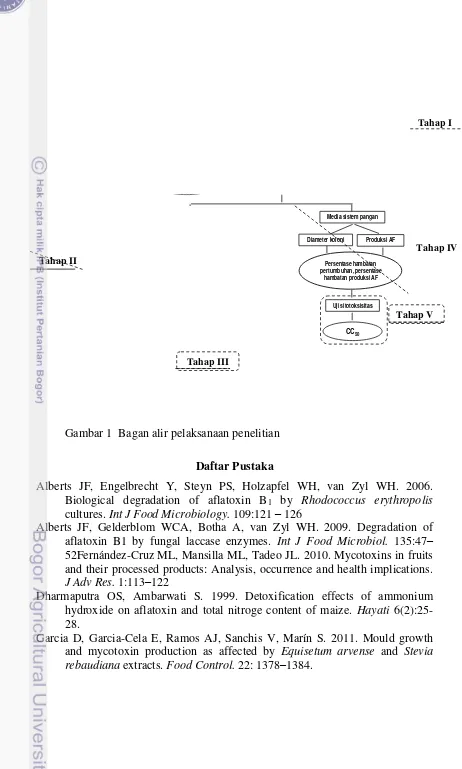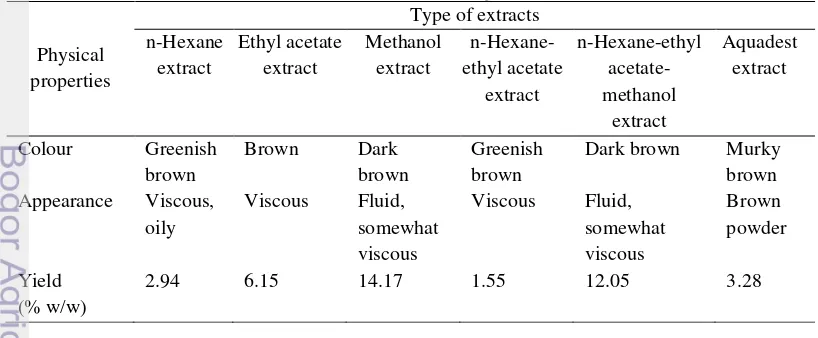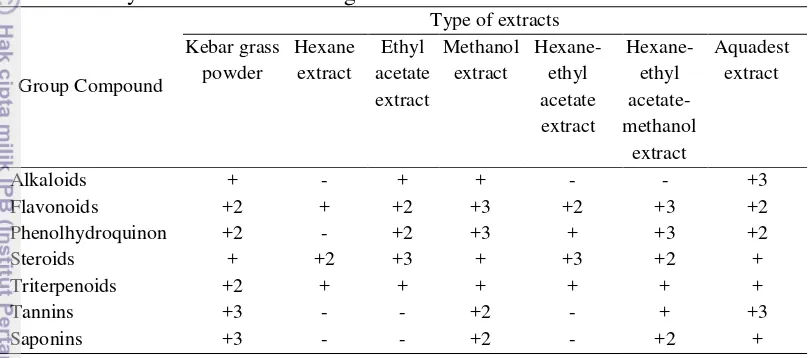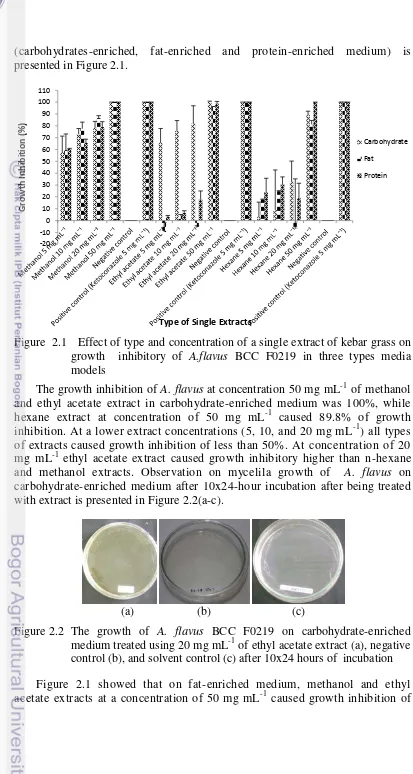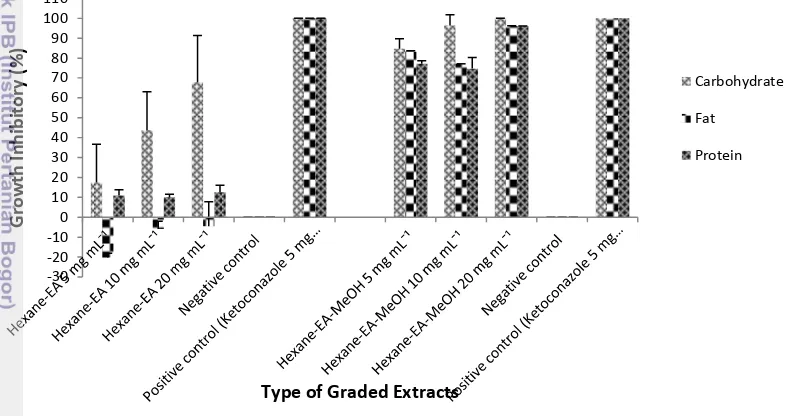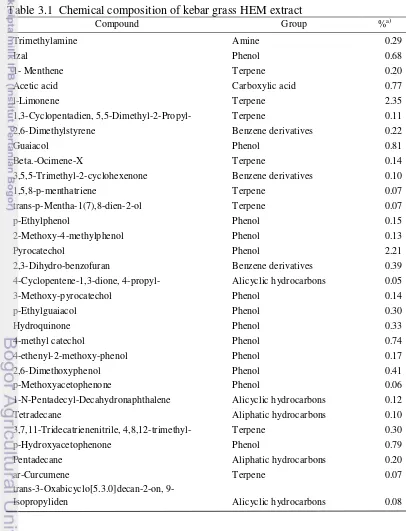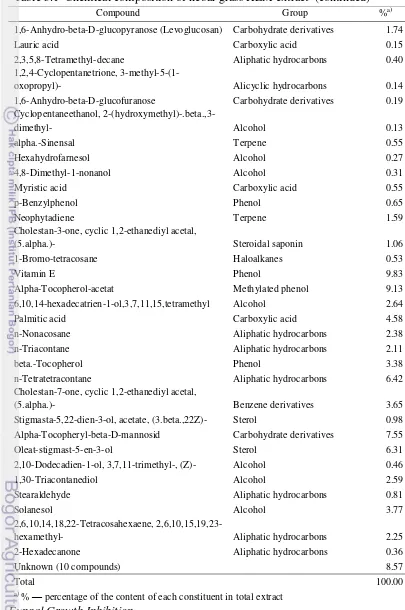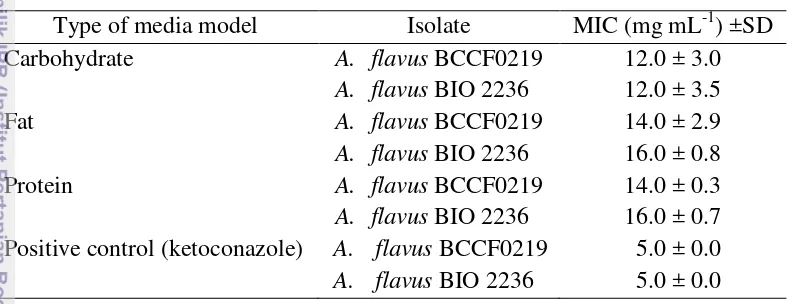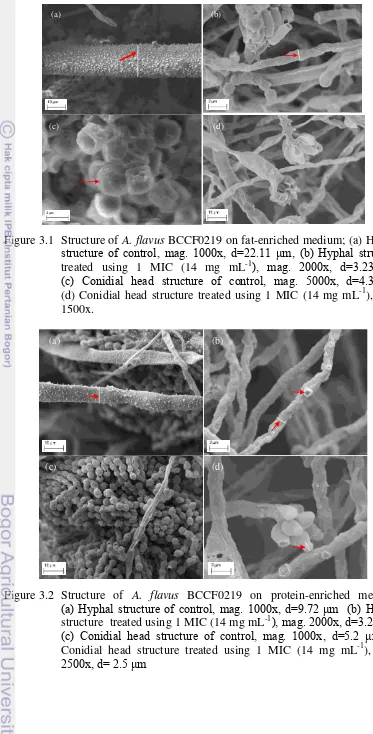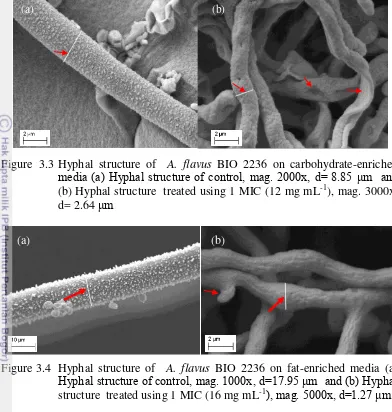EKSTRAK DAUN RUMPUT KEBAR (
Biophytum petersianum
) SEBAGAI
ANTIKAPANG
Aspergillus flavus
TOKSIGEN DAN ANTIAFLATOKSIN
SERTA APLIKASINYA PADA SISTEM PANGAN
MEIKE MEILAN LISANGAN
SEKOLAH PASCASARJANA INSTITUT PERTANIAN BOGOR
PERNYATAAN MENGENAI DISERTASI DAN
SUMBER INFORMASI SERTA PELIMPAHAN HAK CIPTA
Dengan ini saya menyatakan bahwa disertasi berjudul Ekstrak Daun Rumput Kebar (Biophytum petersianum) sebagai Antikapang Aspergillus flavus Toksigen dan Antiaflatoksin serta Aplikasinya pada Sistem Pangan adalah benar karya saya dengan arahan dari komisi pembimbing dan belum diajukan dalam bentuk apa pun kepada perguruan tinggi mana pun. Sumber informasi yang berasal atau dikutip dari karya yang diterbitkan maupun tidak diterbitkan dari penulis lain telah disebutkan dalam teks dan dicantumkan dalam Daftar Pustaka di bagian akhir disertasi ini.
Dengan ini saya melimpahkan hak cipta dari karya tulis saya kepada Institut Pertanian Bogor.
RINGKASAN
MEIKE MEILAN LISANGAN. Ekstrak Daun Rumput Kebar (Biophytum petersianum) sebagai Antikapang Aspergillus flavus Toksigen dan Antiaflatoksin serta Aplikasinya pada Sistem Pangan. Dibimbing oleh RIZAL SYARIEF, WINIATI P RAHAYU, dan OKKY SETYAWATI DHARMAPUTRA.
Beberapa spesies kapang bersifat toksigen, diantaranya Aspergillus flavus yang dapat memproduksi aflatoksin. Berbagai upaya telah dilakukan untuk mencari bahan antikapang dan antiaflatoksin yang berasal dari bahan alami seperti tumbuhan. Biophytum petersianum adalah salah satu tumbuhan herbal yang dikenal oleh masyarakat di Papua Barat dengan nama rumput kebar, dimanfaatkan sebagai obat penyubur kandungan dan sejauh ini menunjukkan aktivitas antibakteri dan berpotensi sebagai antikapang. Tujuan penelitian ini adalah memperoleh jenis ekstrak B. petersianum yang paling efektif sebagai penghambat pertumbuhan kapang Aspergillus flavus toksigen dan penghambat produksi aflatoksin serta mengidentifikasi komposisi kimianya.
Metode penelitian yang digunakan adalah eksperimen, melalui 5 tahap penelitian yang terdiri atas (1) identifikasi fitokimia dan pengujian aktivitas antikapang berbagai jenis ekstrak daun rumput kebar untuk menghambat pertumbuhan A. flavus toksigen, (2) pengujian mekanisme penghambatan ekstrak daun rumput kebar, (3) pengujian antiaflatoksin B1 ekstrak daun rumput kebar
pada media model pangan, (4) pengujian aktivitas antikapang dan antiaflatoksin B1 ekstrak daun rumput kebar pada media sistem pangan berbasis jagung dan
kacang tanah, dan (5) pengujian sitotoksisitas ekstrak daun rumput kebar terhadap sel Vero secara in-vitro.
Daun rumput kebar diekstraksi dengan pelarut heksana, etil asetat, metanol, dan akuades secara tunggal dan bertingkat. Hasil penelitian menunjukkan bahwa ekstrak bertingkat heksana-etil asetat-metanol (HEM) daun rumput kebar pada konsentrasi 20 mg mL-1 di media kaya karbohidrat, media kaya lemak, dan media kaya protein menyebabkan hambatan pertumbuhan A. flavus tertinggi dari pada jenis ekstrak lainnya, yaitu berturut-turut 96.2, 100, dan 96.1%.
Konsentrasi hambatan minimum ekstrak HEM daun rumput kebar terhadap pertumbuhan A. flavus BCCF0219 pada media kaya karbohidrat, kaya lemak, dan kaya protein bertutur-turut sebesar 12 mg mL-1 (97.9%), 14 mg mL-1 (93.5%), dan 14 mg mL-1 (90.8%). Sedangkan konsentrasi hambatan minimum A. flavus BIO 2236 pada media kaya karbohidrat, kaya lemak, dan kaya protein berturut-turut sebesar 12 mg mL-1 (93.9%), 16 mg mL-1 (99.4%) and 16 mg mL-1 (93.8%). Pada 3 tingkat konsentrasi MIC yaitu 1 MIC, 1.5 MIC, dan 2 MIC, persentase hambatan pertumbuhan A. flavus BCCF0219 dan BIO 2236 pada media kaya karbohidrat, lemak, dan protein berkisar antara 90.8 – 100% dan 93.8 – 100%, sedangkan hambatan produksi aflatoksin B1 berkisar antara 70.9 – 100% dan
83.4 – 98.8%. Hasil analisis SEM memperlihatkan bahwa mekanisme yang terlibat dalam penghambatan pertumbuhan kapang oleh ekstrak daun rumput kebar adalah melalui perubahan morfologi hifa yang mengakibatkan kematian sel.
tanah 12.5, 25, 50 dan 100%, persentase hambatan pertumbuhan berturut-turut berkisar pada 75.9 – 100, 72.3 – 100, 63.7 – 100, 64.9 – 100. Reduksi AFB1 pada
media dengan konsentrasi jagung 100% berkisar pada 7.0 – 91.3%, sedangkan pada media dengan konsentrasi kacang tanah 100% berkisar pada 19.3 – 59.4%.
Ekstrak HEM daun rumput kebar menghambat proliferasi sel Vero lebih dari 75% pada tingkat konsentrasi ekstrak 12 – 32 mg mL-1, sedangkan nilai CC50
ekstrak HEM daun rumput kebar adalah 13.41 mg mL-1, jauh lebih besar dari batas yang ditentukan oleh NCI yaitu <20 μg mL-1.
SUMMARY
MEIKE MEILAN LISANGAN. Kebar Grass (Biophytum petersianum) Leaf Extract as Antifungal Toxigenic Aspergillus flavus and Antiaflatoxin and Its Application in Food System. Supervised by RIZAL SYARIEF, WINIATI P RAHAYU, and OKKY SETYAWATI DHARMAPUTRA.
Some fungal species are toxigenic, among others Aspergillus flavus which can produces aflatoxin. Many efforts have been done to investigate the antifungal and antiaflatoxin agents derived from plants. Biophytum petersianum is one of herbs known by the people of West Papua with the name of kebar grass utilized as fertility drugs and showed antibacterial activity and has potency as antifungal. The purpose of this study was to obtain the type of the most effective extract of B. petersianum as growth inhibitors toxigenic Aspergillus flavus and aflatoxin production inhibitor and identify its chemical composition.
The research consisted of 5 research stages i.e. (1) identification of phytochemicals and antifungal activity assay of kebar grass leaf extracts to inhibit the growth of toxigenic Aspergillus flavus, (2) inhibitory mechanism assay of kebar grass leaf extract, (3) antiaflatoxin B1 of kebar grass leaf extract in food
model media, (4) antifungal and antiaflatoxin B1 activity of kebar grass leaf
extract in maize and peanut based media, and (5) in-vitro cytotoxicity of kebar grass leaf extract on Vero cell.
Kebar grass leaf was extracted using hexane, ethyl acetate, methanol, and aquadest in single and successively way. The results showed that kebar grass extract of hexane-ethyl acetate-methanol at concentration of 20 mg mL-1 in carbohydrate-enriched medium, fat-enriched medium, and protein-enriched medium caused higher growth inhibition of A. flavus than the other extracts, i.e. 96.2, 100, and 96.1%, respectevely.
Minimum inhibitory concentration (MIC) of kebar grass HEM leaf extract on the growth of A. flavus BCCF0219 on carbohydrate-enriched medium, fat-enriched medium, and protein-fat-enriched medium were 12 mg mL-1 (97.9%), 14 mg mL-1 (93.5%), dan 14 mg mL-1 (90.8%), respectevely. Meanwhile, MIC of kebar grass HEM leaf extract on the growth of A. flavus BIO 2236 on carbohydrate-enriched medium, fat-carbohydrate-enriched medium, and protein-carbohydrate-enriched medium were 12 mg mL-1 (93.9%), 16 mg mL-1 (99.4%) and 16 mg mL-1 (93.8%), respectevely. At 3 different levels of MIC i.e. 1 MIC, 1.5 MIC and 2 MIC, the percentage of growth inhibition of A. flavus BCC F0219 and BIO 2236 in carbohydrate, fat and protein-enriched medium ranged between 90.8 - 100 % and 93.8 - 100 %, meanwhile, the inhibitory effect of Aflatoxin B1 production ranged between 70.86 - 100 % and 83.42 - 98.84 %. Based on SEM observation results, it was found that the mechanisms involved in fungal growth inhibitory of KGE were by morphological alterations of hyphal development, even the collapse of the entire hyphae.
100, 63.7 - 100, 64.9 - 100%. Reduction of AFB1 at 100% maize based media
ranged at 7.0 - 91.3%, while the range for peanuts at 19.3 - 59.4%.
Kebar grass leaf HEM extract can inhibit Vero cell proliferation more than 75% at concentration of 12 – 32 mg mL-1, while CC50 value of kebar grass leaf
© Hak Cipta Milik IPB, Tahun 2014
Hak Cipta Dilindungi Undang-Undang
Dilarang mengutip sebagian atau seluruh karya tulis ini tanpa mencantumkan atau menyebutkan sumbernya. Pengutipan hanya untuk kepentingan pendidikan, penelitian, penulisan karya ilmiah, penyusunan laporan, penulisan kritik, atau tinjauan suatu masalah; dan pengutipan tersebut tidak merugikan kepentingan IPB
Disertasi
sebagai salah satu syarat untuk memperoleh gelar Doktor
pada
Program Studi Ilmu Pangan
EKSTRAK DAUN RUMPUT KEBAR (
Biophytum petersianum
) SEBAGAI
ANTIKAPANG
Aspergillus flavus
TOKSIGEN DAN ANTIAFLATOKSIN
SERTA APLIKASINYA PADA SISTEM PANGAN
SEKOLAH PASCASARJANA INSTITUT PERTANIAN BOGOR
BOGOR 2014
Penguji pada Ujian Tertutup: Prof. Dr. Ir. Tun Tedja Irawadi, MS Dr. Nur Wulandari, STP, MSi
Judul Disertasi : Ekstrak Daun Rumput Kebar (Biophytum petersianum) sebagai Antikapang Aspergillus flavus Toksigen dan Antiaflatoksin serta Aplikasinya Pada Sistem Pangan Nama : Meike Meilan Lisangan
NIM : F261090071
Disetujui oleh Komisi Pembimbing
Prof Dr Rizal Syarief Ketua
Prof Dr Winiati P Rahayu Anggota
Prof Dr Okky Setyawati Dharmaputra Anggota
Diketahui oleh
Ketua Program Studi Ilmu Pangan
Prof Dr Ratih Dewanti-Hariyadi
Dekan Sekolah Pascasarjana
Dr Dahrul Syah
PRAKATA
Puji dan syukur kepada Tuhan Yang Maha Esa karena atas
rahmat-Nya sehingga disertasi dengan judul ” Ekstrak Daun Rumput Kebar
(Biophytum petersianum) sebagai Antikapang Aspergillus flavus Toksigen dan Antiaflatoksin serta Aplikasinya Pada Sistem Pangan” dapat diselesaikan dengan baik. Bagian dari disertasi ini berupa artikel ilmiah berjudul “Antifungal activity of Kebar grass leaf extracts on the growth of aflatoxigenic flavus in food model media” telah dipresentasikan dalam 1st BIOTROP Conference, Oktober 2013 di IPB Convention Center (ICC) Bogor, dan telah diterima untuk diterbitkan pada International Journal Sciences: Basic and Applied Research Vol. 17 No. 2, 2014. Sebuah artikel berjudul “Effect of kebar grass (Biophytum petersianum) leaf extract on the growth and morphological structure of aflatoxigenic Aspergillus flavus” telah dipresentasikan pada International Symposium on Tropical Fungi, September 2013 dan telah dimasukkan pada International Journal of Food Science and Technology. Artikel lainnya berjudul “Aktivitas antiaflatoksin B1 ekstrak daun rumput kebar (Biophytum petersianum) terhadap
Aspergillus flavus” telah diterima untuk dipublikasi pada Jurnal Agritech Vol. 35 No. 1, Februari 2015.
Pada kesempatan ini penulis mengucapkan terima kasih dan penghargaan sebesar-besarnya kepada:
1. Prof. Dr. Rizal Syarief, Prof. Dr. Winiati P Rahayu dan Prof. Dr. Okky Setyawati Dharmaputra selaku komisi pembimbing atas curahan waktu, arahan dan bimbingannya sehingga disertasi ini dapat diselesaikan dengan baik.
2. Prof. Dr. Tun Tedja Irawadi dan Dr. Nur Wulandari selaku penguji pada ujian tertutup, Dr. Nancy Dewi Yuliana dan Dr. Raphaella Widiastuti selaku penguji pada ujian terbuka.
3. Ketua dan Sekretaris Program Studi Ilmu Pangan serta seluruh staf pengajar dan karyawan atas ilmu pengetahuan dan bantuan yang telah diberikan selama menempuh pendidikan.
4. Direktorat Jenderal Pendidikan Tinggi atas dukungan beasiswa BPPS selama menempuh pendidikan.
5. Rektor Universitas Negeri Papua (UNIPA) Manokwari yang telah memberi kesempatan bagi penulis untuk melanjutkan pendidikan di Institut Pertanian Bogor.
6. Southeast Asian Regional Centre for Tropical Biology (SEAMEO BIOTROP) atas pendanaan penelitian dalam bentuk BIOTROP PhD Thesis Grant tahun 2012.
7. PEMDA Provinsi Papua Barat yang telah memberi bantuan beasiswa penelitian dan PT Freeport yang telah memberi bantuan dana penelitian melalui Lembaga Pemberdayaan Masyarakat Amugme Komoro (LPMAK) Timika, Papua.
9. Teman-teman seperjuangan IPN 2009 (Mbak Mardiah, Bu Aswita, Bu Zita, Bu Siti, Bu Tita, Ai) dan rekan-rekan IMAPA (Ikatan Mahasiswa Papua) Bogor atas suntikan semangatnya.
10. Yang saya hormati dan sayangi kedua orang tua (Bpk. Jaya Taufan Lie dan Ibu Marthina Tan Bonai-Abaa), mertua (Bpk. Welhelmus Talakua dan Ibu Josephine Kayadoe), suami (Richard Talakua), anak-anak yang saya cintai (Hazella Ishera Talakua, Jehefar Dearic Talakua, Ellysia Nathania Talakua, dan Elldora Nathaniela Talakua), serta seluruh keluarga besar atas doa dan dukungannya.
Semoga karya ilmiah ini bermanfaat untuk semua pihak.
i
DAFTAR ISI
RINGKASAN SUMMARY
HALAMAN PENGESAHAN KATA PENGANTAR
DAFTAR ISI
1 PENDAHULUAN
Latar Belakang ... 1
Tujuan Penelitian ... 2
Hipotesis Penelitian ... 2
Manfaat Penelitian ... 3
Ruang Lingkup Penelitian ... 3
Daftar Pustaka ... 4
2 ANTIFUNGAL ACTIVITY OF KEBAR GRASS (Biophytum petersianum) LEAF EXTRACTS ON THE GROWTH OF AFLATOXIGENIC Aspergillus flavus IN FOOD MODEL MEDIA Abstract ... 6
Introduction ... 7
Materials and Methods ... 8
Results and Discussion ... 10
Conclusion ... 16
References ... 16
3 EFFECT OF KEBAR GRASS (Biophytum petersianum) LEAF EXTRACT ON THE GROWTH AND MORPHOLOGICAL STRUCTURE OF AFLATOXIGENIC Aspergillus flavus Abstract ... 19
Introduction ... 19
Materials and Methods ... 20
Results and Discussion ... 23
Conclusion ... 31
References ... 32
4 AKTIVITAS ANTIAFLATOKSIN B1 EKSTRAK DAUN RUMPUT KEBAR (Biophytum petersianum) TERHADAP Aspergillus flavus Abstract ... 35
Pendahuluan ... 36
Metode Penelitian... 37
Hasil dan Pembahasan... 39
Kesimpulan ... 44
ii
5 ANTIKAPANG DAN ANTIAFLATOKSIN B1 EKSTRAK DAUN
RUMPUT KEBAR (Biophytum petersianum) PADA MEDIA BERBASIS JAGUNG DAN KACANG TANAH
Abstract ... 49
Pendahuluan ... 49
Bahan dan Metode... 51
Hasil dan Pembahasan... 53
Kesimpulan ... 57
Daftar Pustaka ... 57
6 UJI SITOTOKSISITAS EKSTRAK DAUN RUMPUT KEBAR (Biophytum petersianum Klotzsch) Abstract ... 60
Pendahuluan ... 60
Bahan dan Metode... 61
Hasil dan Pembahasan... 62
Kesimpulan ... 67
Daftar Pustaka ... 67
7 PEMBAHASAN UMUM ... 69
Daftar Pustaka ... 73
1 PENDAHULUAN
Latar Belakang
Pertumbuhan kapang pada bahan pangan selama penyimpanan dapat menyebabkan peningkatan kadar air bahan dan kelembaban relatif tempat penyimpanan. Pada kondisi demikian kerusakan terjadi dengan cepat sehingga sumber nitrogen bahan yang diperlukan kapang untuk tumbuh juga berkurang. Apabila persediaan nitrogen telah habis maka kapang mempertahankan hidupnya dengan memanfaatkan karbon yang ada dalam bahan sebagai sumber energi. Keadaan ini berlangsung dengan cara kapang melakukan metabolisme sekunder yang dapat menghasilkan mikotoksin (Syarief et al. 2012). Kontaminasi kapang dan produksi mikotoksinnya menyebabkan kerugian 25 - 40% atau bahkan lebih, terutama di negara berkembang (Murugan et al. 2013). Beberapa jenis mikotoksin utama yang telah diidentifikasi antara lain aflatoksin, okratoksin, patulin, islanditoksin, zearalenon, sterigmatosistin, trikotesen, asam penisilat, sitrinin, sporidesmin, rubratoksin, dan slaframin (Fernández-Cruz et al. 2010). Dari sekian banyak mikotoksin ini, aflatoksin merupakan jenis mikotoksin yang perlu lebih mendapat perhatian.
Aflatoksin merupakan toksin yang dihasilkan oleh kapang Aspergillus flavus dan A. parasiticus yang bersifat hepatotoksik, mutagenik, teratogenik, dan karsinogenik bagi manusia dan hewan (Alberts et al. 2006). Aflatoksin B1
merupakan jenis aflatoksin yang paling banyak diproduksi dan memiliki sifat mutagenik, karsinogenik, dan teratogenik yang sangat tinggi, baik terhadap manusia maupun hewan. Kontaminasi aflatoksin yang terjadi di Afrika, Tiongkok, dan Asia Tenggara berkorelasi positif dengan tingkat kejadian kanker hati. Selain berbahaya bagi kesehatan manusia dan hewan, kontaminasi aflatoksin pada pangan dan pakan juga mengakibatkan kerugian ekonomi yang cukup signifikan berkisar antara US $85 - 100 juta di USA (Alberts et al. 2009).
Hingga saat ini, telah banyak upaya yang dilakukan untuk meminimalisir paparan mikotoksin, terutama aflatoksin melalui berbagai macam metode. Diantaranya melalui metode fisik seperti teknik ekstruksi (Syarief et al. 2012) dan pemanasan dengan kombinasi penambahan buffer fosfat (Saalia dan Phillips 2010), metode kimia seperti penggunaan amonia (Dharmaputra dan Ambarwati 1999), dan metode biologi dengan menggunakan Bakteri Asam Laktat (Topcu et al. 2010) juga telah dilakukan. Selain itu beberapa peneliti juga telah mencoba mereduksi aflatoksin dengan menggunakan agen botani seperti ekstrak tumbuhan
dari spesies Agave (Sánchez et al. 2005), ekstrak tumbuhan Allium cepa, A. sativum dan A. indica (Reddy et al. 2009), ekstrak tumbuhan Equisetum
arvense dan Stevia rebaudiana (Garcia et al. 2011) yang cukup efektif mereduksi pertumbuhan kapang (86 – 100%) dan produksi aflatoksin.
luka lambung, malaria, dan demam (Inngjerdingen et al. 2008). Masyarakat Papua sendiri, terutama di Distrik Kebar sering menggunakan tumbuhan ini sebagai obat penyubur kandungan. Berdasarkan pengalaman empiris masyarakat setempat, tumbuhan ini telah terbukti mampu meningkatkan kesuburan wanita sehingga selain digunakan oleh masyarakat setempat, tumbuhan ini bahkan telah diperdagangkan hingga keluar wilayah Papua. Santoso et al. (2007) dan Karamang (2010) mengemukakan bahwa rumput kebar memiliki kandungan alkaloid, saponin, tanin, fenolik, flavonoid, triterpenoid, steroid, dan glikosida. Komponen-komponen tersebut banyak diteliti sebagai komponen bioaktif yang dapat berperan sebagai antioksidan dan antimikrob. Keberadaan kelompok bioaktif yang cukup lengkap dalam rumput kebar membuat tumbuhan ini berpotensi sebagai antimikrob. Beberapa kajian yang dilakukan memperlihatkan aktivitas antibakteri dari ekstrak daun Rumput kebar terhadap bakteri patogen Gram positif (Bacillus subtilis, Staphylococcus aureus, Streptococcus pneumoniae) dan Gram negatif (Klebsiella pneumonia, Salmonella Typhii, Proteus vulgaris, Escherichia coli) (Natarajan et al. 2010), namun sejauh ini belum ada laporan tentang aktivitas antikapang dari rumput kebar.
Jenis substrat merupakan salah satu faktor yang dapat menentukan kandungan aflatoksin yang dihasilkan oleh A. flavus aflatoksigen. Substrat dalam bahan pangan dapat terdiri dari karbohidrat, lemak dan protein, sehingga perlu mengkaji pengaruh ekstrak rumput kebar terhadap pertumbuhan A. flavus aflatoksigen dan produksi aflatoksin B1 (AFB1) pada berbagai jenis substrat bahan
pangan. Potensi penggunaan rumput kebar sebagai antikapang diharapkan dapat menghambat pertumbuhan kapang terutama kapang aflatoksigen serta produksi aflatoksin B1 pada bahan pangan.
Tujuan Penelitian
Tujuan penelitian secara umum adalah untuk mengkaji aktivitas antikapang dan antiaflatoksin B1 ekstrak daun rumput kebar pada media model pangan dan
media sistem pangan.
Secara khusus, penelitian ini bertujuan untuk :
1. Menentukan jenis ekstrak rumput kebar yang paling efektif menghambat pertumbuhan kapang A. flavus toksigen dan mengetahui mekanisme kerjanya.
2. Mengetahui potensi rumput kebar sebagai antikapang A. flavus dan antiaflatoksin B1 pada media model pangan dan sistem pangan.
3. Mengetahui sitotoksisitas ekstrak daun rumput kebar terhadap sel Vero secara in vitro
Hipotesis Penelitian
Hipotesis yang diajukan pada penelitian ini adalah :
1. Ekstrak rumput kebar memiliki potensi sebagai antikapang A. flavus toksigen pada media model pangan.
2. Ekstrak rumput kebar memiliki potensi sebagai agen penghambat produksi aflatoksin B1 dalam sistem pangan.
Manfaat Penelitian
Hasil penelitian ini diharapkan dapat memberi informasi baru mengenai komponen aktif yang terdapat pada rumput kebar dan kemampuannya sebagai antikapang A. flavus toksigen dan agen penghambat produksi aflatoksin. Diharapkan rumput kebar dapat digunakan sebagai bahan tambahan pangan yang berfungsi sebagai antikapang A. flavus toksigen dan antiaflatoksin B1.
Ruang Lingkup Penelitian
Penelitian ini dilakukan melalui lima tahapan yaitu: (1) Identifikasi fitokimia dan pengujian aktivitas antikapang berbagai jenis ekstrak daun rumput kebar untuk menghambat pertumbuhan A. flavus toksigen, (2) Pengujian mekanisme penghambatan ekstrak daun rumput kebar, (3) Pengujian
antiaflatoksin B1 ekstrak daun rumput kebar pada media model pangan,
(4) Pengujian aktivitas antikapang dan antiaflatoksin B1 ekstrak daun rumput
kebar pada media sistem pangan berbasis jagung dan kacang tanah, (5) Pengujian sitotoksisitas ekstrak daun rumput kebar terhadap sel Vero secara in vitro.
Pelarut yang digunakan untuk ekstraksi menggunakan tiga jenis pelarut yaitu pelarut non-polar, semi-polar dan polar yang masing-masing diwakili oleh n-heksana, etil asetat dan metanol. Isolat yang digunakan merupakan isolat aflatoksigen yaitu isolat BCC F0219 yang dicirikan dengan pertumbuhan yang sangat cepat dan produksi konidium yang berlimpah, dan BIO 2236 yang bercirikan produksi konidium sedikit tetapi produksi aflatoksin B1 tinggi.
Gambar 1 Bagan alir pelaksanaan penelitian Daftar Pustaka
Alberts JF, Engelbrecht Y, Steyn PS, Holzapfel WH, van Zyl WH. 2006. Biological degradation of aflatoxin B1 by Rhodococcus erythropolis
cultures. Int J Food Microbiology. 109:121 – 126
Alberts JF, Gelderblom WCA, Botha A, van Zyl WH. 2009. Degradation of aflatoxin B1 by fungal laccase enzymes. Int J Food Microbiol. 135:47– 52Fernández-Cruz ML, Mansilla ML, Tadeo JL. 2010. Mycotoxins in fruits and their processed products: Analysis, occurrence and health implications. J Adv Res. 1:113–122
Dharmaputra OS, Ambarwati S. 1999. Detoxification effects of ammonium hydroxide on aflatoxin and total nitroge content of maize. Hayati 6(2):25-28.
Garcia D, Garcia-Cela E, Ramos AJ, Sanchis V, Marín S. 2011. Mould growth and mycotoxin production as affected by Equisetum arvense and Stevia rebaudiana extracts. Food Control. 22: 1378–1384.
Persentase hambatan pertumbuhan, persentase hambatan
produksi AF
Rumput Kebar
Ekstraksi dengan pelarut organik dan akuades
Ekstrak Etil asetat Ekstrak Metanol Ekstrak Heksana Ekstrak Akuades Ekstrak Heksana-etil asetat Ekstrak Heksana-Etil asetat-Metanol
Uji fitokimia kualitatif Uji Aktivitas antikapang
Media model pangan Media sistem pangan
Diameter koloni Produksi konidium
Diameter koloni
Identifikasi golongan senyawa
Py/GCMS
Uji sitotoksisitas Mekanisme antikapang
Ekstraksi Tunggal Ekstraksi Bertingkat
Data fitokimia Jenis ekstrakterpilih
Diameter koloni Produksi AF
Persentase hambatan pertumbuhan, data MIC Produksi AF Golongan senyawa Persentase hambatan pertumbuhan, persentase
hambatan produksi AF
Imbiri ANNH, Wanggai F, Maturbongs RA. 2000. An ecological aspect of Biophytum petersianum Klotzsch in Kebar district, Manokwari, Irian Jaya. Beccariana. 2 (2):44 -47.
Inngjerdingen M, Inngjerdingen KT, Patel TR, Allen S, Chen X, Rolstad B, Morris GA, Harding SE, Michaelsen TE, Diallo D, Paulsen BS. 2008. Pectic polysaccharides from Biophytum petersianum Klotzsch, and their activation of macrophages and dendritic cells. Glycobiology. 12:1074–1084.
Karamang S. 2010. Studi Morfologi, Agrobiofisik dan Produksi Saponin Rumput Kebar (Biophytum petersianum Klotzsch) Asal Papua [tesis]. Bogor (ID): Fakultas Teknologi Pertanian, Institut Pertanian Bogor.
Murugan K, Anandaraj K, Al-Sohaibani S. 2013. Antiaflatoxigenic food additive potential of Murraya koenigii : An in vitro and molecular interaction study. Food Res Int. 52:8 – 16
Natarajan D, Shivakumar MS, Srinivasan R. 2010. Antibacterial activity of leaf extracts of Biophytum sensitivum (L.) DC. J Pharm Sci Res. 11:717-720 Reddy KRN, Reddy CS, Muralidharan K. 2009. Potential of botanicals and
biocontrol agents on growth and aflatoxin production by Aspergillus flavus infecting rice grains. Food Control. 20:173–178
Saalia FK, Phillips RD. 2010. Degradation of aflatoxins in aqueous buffer in the presence of nucleophiles. Food Control. 21:1066–1069
Sa´nchez E, Heredia N, Garcia S. 2005. Inhibition of growth and mycotoxin production of Aspergillus flavus and Aspergillus parasiticus by extracts of Agave species. Int J Food Microbiol. 98:271 – 279
Santoso B, Kilmaskossu A, Sambodo P. 2007. Effects of saponin from Biophytum petersianum Klotzsch on ruminal fermentation, microbial protein synthesis and nitrogen utilization in goats. Animal Feed Sci Tech. 137:58–68.
Syarief R, La Ega, Nurwitri CC. 2012. Mikotoksin Bahan Pangan Ed.2. Bogor (ID): IPB Pr.
Topcu A, Bulat T, Wishah R, Boyac IH. 2010. Detoxification of aflatoxin B1 and
2 ANTIFUNGAL ACTIVITY OF KEBAR GRASS
(
Biophytum petersianum
) LEAF EXTRACTS ON THE
GROWTH OF AFLATOXIGENIC
Aspergillus flavus
IN FOOD MODEL MEDIA
1,2)ABSTRACT
Some fungal species are toxigenic, for example Aspergillus flavus which can produces aflatoxin. Various methods have been conducted to reduce aflatoxin contamination in foods, among others using antimicrobial compounds derived from natural plant extract. Kebar grass (Biophytum petersianum) is one of herbs that has potency as antimicrobe. The objective of this study was to investigate the effect of three types of model media i.e. carbohydrate- enriched media, fat-enriched media, and protein- enriched media containing kebar grass leaf extract on the growth of aflatoxigenic A. flavus. Kebar grass leaf extract at concentrations of 5, 10, and 20 mg mL-1 was extracted using various solvents, i.e. hexane, ethyl acetate, methanol, hexane-ethyl acetate, hexane-ethyl acetate-methanol, and aquadest. The extracts were tested on the growth of A. flavus. The result showed that kebar grass leaf extract of hexane-ethyl acetate-methanol at concentration of 20 mg mL-1 in carbohydrate-enriched medium, fat-enriched medium, and protein-enriched medium caused highest growth inhibition of A. flavus compared to extracts, i.e. 96.2, 100, and 96.1%, respectively. The other extracts caused growth inhibition less than 90%. The results showed that kebar grass leaf extract can inhibit the growth of toxigenic A. flavus.
Keywords: antifungal activity, aflatoxigenic Aspergillus flavus, Biophytum petersianum, food model media
ABSTRAK
Beberapa spesies kapang bersifat toksigen, diantaranya Aspergillus flavus yang dapat memproduksi aflatoksin. Berbagai metode telah dilakukan untuk mereduksi kontaminasi aflatoksin pada bahan pangan, diantaranya menggunakan komponen antimikrob yang berasal dari ekstrak tumbuhan alami. Rumput kebar (Biophytum petersianum) adalah salah satu tumbuhan herbal yang berpotensi sebagai antimikrob. Tujuan penelitian ini adalah untuk mengkaji pengaruh tiga jenis media model yaitu media kaya karbohidrat, media kaya lemak, dan media kaya protein yang mengandung ekstrak daun rumput kebar terhadap pertumbuhan A. flavus aflatoksigen. Ekstrak rumput kebar pada konsentrasi 5, 10, dan 20 mg mL-1 yang diekstraksi menggunakan heksana, etil asetat, metanol, heksana-etil asetat, heksana-etil asetat-metanol, dan akuades diuji terhadap pertumbuhan A. flavus.
1)
Has been presented in 1st BIOTROP International Conference, October 3-4th 2013, Bogor-Indonesia.
2)
Hasil penelitian menunjukkan bahwa ekstrak bertingkat heksana-etil asetat-metanol rumput kebar pada konsentrasi 20 mg mL-1 di media kaya karbohidrat, media kaya lemak, dan media kaya protein menyebabkan hambatan pertumbuhan A. flavus tertinggi dibandingkan dengan jenis ekstrak lainnya, yaitu berturut-turut 96.2, 100, dan 96.1%. Jenis ekstrak lainnya menyebabkan hambatan pertumbuhan kurang dari 90%. Hasil yang diperoleh dari penelitian ini mengindikasikan bahwa ekstrak daun rumput kebar dapat digunakan untuk menghambat pertumbuhan A. flavus toksigen.
Kata kunci: aktivitas antikapang, Aspergillus flavus aflatoksigen, Biophytum petersianum, media model pangan
1. Introduction
Foods are easily spoiled by either bacteria or fungi. During pre and post -harvest handling foodstuffs can be infected by fungi. Some fungal species among others Aspergilus flavus can produce toxins (aflatoxins) which can cause liver cancer on human and animal [1]. Many efforts have been done to extend the shelf life of foods and its safety, for example using thermal and non-thermal processing techniques or the use of preservatives such as synt hetic or natural antioxidants and antimicrobes. Plant metabolites have been known to have antimicrobial and antioxidant activities and some of them are classified as Generally Recognized as Safe Substances (GRAS) [2,3].
One of the biological material that could be used as antimicrobe is kebar grass (Biophytum petersianum), a plant belong to family Oxalidaceae. In Indonesia, the plant is found in Kebar District, West Papua. The plant grows naturally and spread almost all over Kebar District [4]. Besides in Kebar District, this plant is also found in Southeast Asia and Africa, especially in Mali region. Mali community use this plant for the treatment of wounds, inflammation, ulcers, malaria, and fever [5]. Papuan community, especially in Kebar District often use this plant as a fertility drug.
It was reported that kebar grass contains bioactive compounds such as alkaloids, saponins, tannins, phenolic, flavonoids, triterpenoids, steroids and glycosides compounds [4,6]. As kebar grass contains fairly complete bioactive groups, therefore this plant is potential could be used as antimicrobe. [7] reported that the leaf extract of kebar grass has antibacterial activity against Gram-positive bacteria (Bacillus subtilis, Staphylococcus aureus, Streptococcus pneumoniae) and Gram-negative bacteria (Klebsiella pneumonia, Salmonella Typhii, Proteus vulgaris, Escherichia coli), but there are no reports concerning the effect of kebar grass against toxigenic mold.
2. Materials and Methods
2.1 Extraction and Determination of Phytochemicals Content of Kebar Grass Leaf Extracts
Kebar grass leaves and aflatoxigenic A. flavus
Kebar grass were collected from Kebar district, Manokwari county, West Papua province, in February, 2013. Identification of kebar grass was confirmed by Indonesian Institute of Science (LIPI). Leaves of kebar grass were then air-dried for about 2 weeks until their colour turned into golden brown and they are easily broken. The leaves were then crushed into 40 mesh coarse powder using a blender (Philips). One strain of aflatoxigenic A. flavus BCCF0219 obtained from Indonesian Research Center for Veterinary Science culture collection was used in this study.
Chemicals
All chemicals were of analytical grade purchased from JT. Baker, USA. Single extraction using organic solvents
A method of [8] was used to obtain the extract of kebar grass leaves. Powder of kebar grass leaves was extracted using maceration method and various organic solvents, i.e. a non-polar (n-hexane), semi-polar (ethyl acetate), and polar organic solvent (methanol). The kebar grass powder (200 g) was placed in a glass jar (volume 1000 mL), then 800 mL n-hexane was added. Its mixture was macerated for one hour at room temperature (28 – 30 °C), stirred in a shaker that combined with sonification for 30 minutes, followed by further maceration for one hour then filtered using Whatman No.1 filter paper. The extraction was conducted three times. The extract was collected and dried using a rotary evaporator to form a thick concentrate. The remaining solvent was removed using nitrogen gas. The yield of extract was calculated as the percentage of extract (mg extract/100 g kebar grass powder). Extraction using ethyl acetate and methanol was conducted with the same way. The extraction process was performed in triplicate. The extracts stored at 4°C until used.
Extraction using distilled water
Kebar grass leaves were extracted in distilled water (60 0C) for one hour. The extract was centrifuged at 5000 xg for 10 minutes, the supernatant was collected and dried using freeze drier to form a powder and the dry weight of extract was determined. The yield of extract was calculated as the percentage of extract (mg extract/100 g kebar grass powder). The extraction process was performed in triplicate. The extract was stored at 4°C until used [9].
Successively extraction by using n-hexane-ethyl acetate-methanol
sequentially in a similar manner. The filtrate was collected and dried using a rotary evaporator to form a thick concentrate. The hexane-ethyl acetate-methanol filtrate was called as HEM extract. Residual solvent in HEM extract was removed using nitrogen gas [8]. The extract was then stored at 4 °C until used.
Phytochemical test
Phytochemical tests were performed on crude organic extract and aqueous extract of kebar grass leaves. The tests were conducted to determine the content of flavonoids, tannins, alkaloids, phenylhydroquinon, triterpenoids, and saponins [10].
2.2.Antifungal Activity Screening of Kebar Grass Extract in Food Model Media
Preparation of agar medium enriched with carbohydrate, fat, and protein
Carbohydrate-enriched medium was prepared by the addition of 30% (w/v) glucose on Bacto Agar. The medium was sterilized in an autoclave at 121 °C for 15 minutes [11].
Medium enriched with fat was prepared based on [12]. One hundred grams of grated coconut flesh was homogenized using 300 mL of hot distilled water for five minutes. The mixture was filtered adjusted its pH into 7.0 using NaOH 2M. Agar powder was added (20 g L-1), and sterilized in an autoclave at 121°C for 15 minutes.
Protein-enriched medium was prepared using the method of [13] with a slight modification on the type of protein source. As much as 30% (w/v) skim milk obtained from Difco Laboratory was added to Bacto Agar medium and sterilized in an autoclave at 121°C for 10 minutes.
Preparation of A. flavus conidia
The conidia of A. flavus were prepared using the method of [14] with a slight modification. The fungus was cultured in PDA slant and incubated at 28°C for 5 days. The conidia were harvested by adding 10 mL of sterile distilled water and collected aseptically. Conidial suspension was dissolved in Tween 80 (0.5%) and centrifuged (2000xg) at 28 – 30 °C for five minutes. Conidial concentration was calculated using a haemacytometer and adjusted to 106 CFU mL-1.
Mycelial Growth Assay
used for each treatment. The percentage of inhibitory growth was determined using the following formula:
(dc - dt)
Growth Inhibition = X 100%, dc
where dc = diameter of fungal colony in medium without kebar grass extract (mm)
dt = diameter of fungal colony in medium containing the extract of kebar grass (mm)
2.3.Statistical Analyses
The results were analyzed using Microsoft Excel 2007. All the values are expressed as means ± standard deviation (n=2).
3. Results and Discussion
3.1.Yield and Physical Properties of Kebar Grass Extracts
Yield and physical properties of kebar grass extracted with single solvent and the combination of various solvents is presented in Table 2.1. Extraction using hexane-ethyl acetate produced the lowest extract yield (1.55%), while a single extraction of methanol produced the highest yield (14.17%). Extract yield of hexane-ethyl acetate was low, because some components were soluble in nonpolar and semipolar solvents, such as steroids were extracted by nonpolar solvent, therefore the less that can be extracted by a semipolar solvent. The yield of a polar extract, either extracted using a single solvent (methanol) or graded solvent (hexane-ethyl acetate-methanol) was high, because of the more polar components were able to be extracted well using polar solvents.
Table 2.1 Yield and physical properties of kebar grass extract
Physical properties
Type of extracts n-Hexane extract Ethyl acetate extract Methanol extract n-Hexane-ethyl acetate extract n-Hexane-ethyl acetate-methanol extract Aquadest extract
Colour Greenish brown
Brown Dark
brown
Greenish brown
Dark brown Murky brown Appearance Viscous,
oily
Viscous Fluid, somewhat viscous
Viscous Fluid, somewhat viscous Brown powder Yield (% w/w)
2.94 6.15 14.17 1.55 12.05 3.28
The difference of solvent polarity resulted different phytochemical components of extract. Phytochemical components produced by various organic solvents is presented in Table 2.2.
flavonoids. Other components that could be extracted using hexane solvent are steroids and triterpenoids. Extraction using ethyl acetate can extract alkaloids, flavonoids, phenylhydroquinon, steroids and triterpenoids, whereas extraction using methanol can extract components such as alkaloids, flavonoids, phenolhydroquinon, steroids, triterpenoids, tannins and saponins. According to [10], alkaloids are components of semipolar alkaline containing one or more nitrogen atoms and are widely used in medicine. Alkaloids are also often used as an antibacterial ingredient that is bactericidal [17,8].
Table 2.2 Phytochemicals of kebar grass extracts
Group Compound
Type of extracts Kebar grass powder Hexane extract Ethyl acetate extract Methanol extract Hexane-ethyl acetate extract Hexane-ethyl acetate-methanol extract Aquadest extract
Alkaloids + - + + - - +3
Flavonoids +2 + +2 +3 +2 +3 +2
Phenolhydroquinon +2 - +2 +3 + +3 +2
Steroids + +2 +3 + +3 +2 +
Triterpenoids +2 + + + + + +
Tannins +3 - - +2 - + +3
Saponins +3 - - +2 - +2 +
Note : + = weak positive; +2 = positive; +3 = strong positive ; - = not detected
Another class of compounds extracted, either using nonpolar, semipolar or polar solvents are flavonoids and phenolhydroquinon, but more strongly extracted in polar solvents, due to these compounds are polar [18]. As an antioxidant [19], flavonoids and phenolhydroquinon also have antimicrobial properties [18,20]. Steroids strongly extracted by hexane and ethyl acetate solvents. This is because most of the steroid is nonpolar and semipolar, so it can be extracted using nonpolar and semipolar solvents. Triterpenoids extracted using hexane, ethyl acetate, and methanol solvent, can be divided into four groups, namely true triterpene, steroids, saponins and cardiac glycosides [10]. Triterpenoids are non-volatile terpenoid compounds. Terpenoids are the building blocks of essential oils. Besides having biological activity, triterpenoids also have antimicrobial properties [21]. Tannins and saponins are highly polar compounds, they can be extracted only using polar solvents. Both classes of compounds have antimicrobial activity [18]. Saponins are surface active compounds and it is like soap, which can be detected by their ability to form foam and hemolyzed blood cells. Saponin has expectorant action, which is very useful in the management of upper respiratory tract inflammation. Saponins was also reported to have antidiabetic properties [22].
3.2.Antifungal Activity of Kebar Grass Single Extract Extracted Using Single Solvent
(carbohydrates-enriched, fat-enriched and protein-enriched medium) is presented in Figure 2.1.
Figure 2.1 Effect of type and concentration of a single extract of kebar grass on growth inhibitory of A.flavus BCC F0219 in three types media models
The growth inhibition of A. flavus at concentration 50 mg mL-1 of methanol and ethyl acetate extract in carbohydrate-enriched medium was 100%, while hexane extract at concentration of 50 mg mL-1 caused 89.8% of growth inhibition. At a lower extract concentrations (5, 10, and 20 mg mL-1) all types of extracts caused growth inhibition of less than 50%. At concentration of 20 mg mL-1 ethyl acetate extract caused growth inhibitory higher than n-hexane and methanol extracts. Observation on mycelila growth of A. flavus on carbohydrate-enriched medium after 10x24-hour incubation after being treated with extract is presented in Figure 2.2(a-c).
(a) (b) (c)
Figure 2.2 The growth of A. flavus BCC F0219 on carbohydrate-enriched medium treated using 20 mg mL-1 of ethyl acetate extract (a), negative control (b), and solvent control (c) after 10x24 hours of incubation Figure 2.1 showed that on fat-enriched medium, methanol and ethyl acetate extracts at a concentration of 50 mg mL-1 caused growth inhibition of
-20 -10 0 10 20 30 40 50 60 70 80 90 100 110
Gr
o
wt
h
In
h
ib
ition
(
%
)
Type of Single Extracts
Carbohydrate Fat
A. flavus more than 90%, i.e. 100 and 96.3% respectively, while hexane and water distilled extracts caused only 81.3 and 45.4% growth inhibition, respectively. At lower concentrations of 5, 10, and 20 mg mL-1, all types of extracts caused growth inhibition less than 90%. At concentration of 20 mg mL-1 methanol extract caused growth inhibition higher than n-hexane and ethyl acetate extracts. Mycelial growth of A. flavus on fat-enriched medium treated using methanol extract after 10x24-hours of incubation are presented in Figure 2.3(a-c).
(a) (b) (c) Figure 2.3 The growth of A. flavus BCC F0219 on fat-enriched medium treated
using 20 mg mL-1 of methanol extract (a), negative control (b), and solvent control (c) after 10x24 hours of incubation
Inhibitions of kebar grass extract using methanol, ethyl acetate and hexane at concentration of 50 mg mL-1 each in protein-enriched medium were 100, 98.6, and 100%, respectively, while at a lower concentration of 5, 10, and 20 mg mL-1, all types of extracts caused growth inhibition less than 90%. At concentration of 20 mg mL-1 methanol extract caused growth inhibition higher than n-hexane and ethyl acetate extracts. Mycelial growth of A. flavus after 10x24-hours of incubation and after treated using extract is presented in Figure 2.4(a-d).
(a) (b) (c)
Figure 2.4 The growth of A. flavus BCC F0219 on protein-enriched medium treated using 20 mg mL-1 of methanol extract (a), negative control (b), and solvent control (c) after 10x24 hours of incubation
Tannins was reported to have physiological astringent properties, which hasten wound healing and ameliorate inflamed mucus membrane, it also has hemostatic properties [22]. Saponin has the property of precipitating and coagulating red blood cells. It is known that saponins can change the membrane permeability leading to the rupture of the cell [23].
3.3.Antifungal Activity of Kebar Grass Graded Solvent Extract
In carbohydrate-enriched medium, hexane-ethyl acetate (HE) extract caused growth inhibition of less than 90%, but the percentage of inhibition was higher than other medium models, on the concentration of extract 5, 10, or 20 mg mL-1 (Figure 2.5). Hexane-ethyl acetate-methanol (HEM) extract at concentrations of 10 and 20 mg mL-1 caused growth inhibition 96.4 and 100%, respectively (Figure 2.5 and 2.6).
Figure 2.5 Effect of type and concentration of kebar grass extract on growth inhibitory of A. flavus BCC F0219 in various media models
(a) (b) (c)
Figure 2.6 The growth of A. flavus BCC F0219 on carbohydrate-enriched medium treated using 10 mg mL-1 of n-hexane-ethyl acetate-methanol extract (a), negative control (b), and solvent control (c) after 10x24 hours of incubation
-30 -20 -10 0 10 20 30 40 50 60 70 80 90 100 110
Gr
o
wt
h
In
h
ib
ito
ry
(
%
)
Type of Graded Extracts
Carbohydrate Fat
In fat-enriched medium, HE extract did not cause any inhibition on the growth of A. flavus, and tended to stimulate the growth of A. flavus (Figure 2.5). According to [10] steroid compounds belonging to the class of triterpenes, some of which include plant sterols that are only found in low level plants such of yeasts and molds. Ergosterol is a major component of the molds cell wall. The presence of high steroid in hexane-ethyl acetate extract did not inhibit the growth of A. flavus, otherwise a supporter of the A. flavus cell wall synthesis.
Hexane-ethyl acetate-methanol (HEM) extract (polar extract) at concentration of 20 mg mL-1 caused 96.2% stunted growth of A. flavus which was higher than the single extract. It is assumed that compounds extracted in graded extraction was more pure and has stronger activity. Mycelial growth of A. flavus on fat-enriched medium after 10x24-hours of incubation and after treated using extract is presented in Figure 2.7.
(a) (b) (c)
Figure 2.7 The growth of A. flavus BCC F0219 on fat-enriched medium treated using 20 mg mL-1 of n-hexane-ethyl acetate-methanol extract (a), negative control (b), and solvent control (c) after 10x24 hours of incubation
Experiment on the protein-enriched medium showed that the kind of hexane-ethyl acetate extract with a concentration of 20 mg mL-1 caused growth inhibition less than 90%, while the kind of hexane-ethyl acetate-methanol extract caused growth inhibition of 96.1%. The lower concentration of ethyl acetate-hexane-methanol extract produces less than 90% inhibition. Mycelial growth of A. flavus on protein-enriched medium after 10x24-hours of incubation and after treated using extract is presented in Figure 2.8.
(a) (b) (c)
Extract HEM rich of flavonoids, phenolhydroquinon, steroids, triterpenoids, tannins, and saponins. The antifungal property in this study could be due to flavonoids and tannins contents of the extract. They are known to have appreciable antimicrobial activities [22]. Other while triterpenoids can reduces the synthesis of ergosterol fungal cell membrane component and cause defective cell wall formation and leakage of cellular contents [24].
4. Conclusion
Kebar grass leaf extract was able to inhibit the growth of A. flavus in food model media. The most effective extract tested (20 mg mL-1) with growth inhibitory 96.1 – 100% was extract of hexane-ethyl acetate-methanol (HEM). Therefore, the kebar grass leaf could be recommended as antifungal of aflatoxigenic A. flavus.
5. Acknowledgment
The authors acknowledge the financial support of the Southeast Asian Regional Centre for Tropical Biology (SEAMEO BIOTROP). 6. References
1. J.I. Pitt and A.D. Hocking. Fungi and Food Spoilage. New York: Springer, 2009.
2. C. Proestos, N. Chorianopoulos, G.J. Nychas and M. Komaitis. RP-HPLC analysis of the phenolic compounds of plant extracts : Investigation of their antioxidant capacity and antimicrobial activity. J Agri and Food Chem., Vol. 53, 1190–1195, 2005.
3. M. Trigui, A.B. Hsouna, S. Tounsi and S. Jaoua. Chemical composition and evaluation of antioxidant and antimicrobial activities of Tunisian Thymelaea hirsuta with special reference to its mode of action. Indust Crops and Prod., Vol. 41, 150-157, 2013. 4. B. Santoso, A. Kilmaskossu and P. Sambodo. Effects of saponin from
Biophytum petersianum Klotzsch on ruminal fermentation, microbial protein synthesis and nitrogen utilization in goats. Animal Feed Sci and Tech., Vol. 137, 58–68, 2007.
5. M. Inngjerdingen, K.T. Inngjerdingen, T.R. Patel, S. Allen, X. Chen, B. Rolstad, G.A. Morris, S.E. Harding, T.E. Michaelsen, D. Diallo and B.S. Paulsen. Pectic polysaccharides from Biophytum petersianum Klotzsch, and their activation of macrophages and dendritic cells. Glycobiol., Vol. 12, 1074–1084, 2008.
6. S. Karamang. Studi morfologi, agrobiofisik dan produksi saponin Rumput Kebar (Biophytum petersianum Klotzsch) asal Papua [tesis].Bogor: Fakultas Teknologi Pertanian, Institut Pertanian Bogor, 2010.
7. D. Natarajan, M.S. Shivakumar and R. Srinivasan. Antibacterial activity of leaf extracts of Biophytum sensitivum (L.) DC. J Pharm Sci and Res., Vol. 11, 717-720, 2010.
9. S.H. Lee, K.S. Chang, M.S. Su, Y.S. Huang and H.D. Jang. Effects of some Chinese medicinal plant extracts on five different fungi. Food Control, Vol. 18, 547–1554, 2007.
10. J.B. Harborne. Metode Fitokimia : Penuntun cara modern menganalisis tumbuhan. Terbitan kedua. Bandung: Penerbit ITB, 2006.
11. C.N. Shih and E.H. Marth. Some cultural conditions that control biosynthesis of lipid and aflatoxin by Aspergillus parasiticus. App Microbiol., Vol. 27, 452-456, 1974.
12. A. Riba, N. Boura, S. Mokrane, F. Mathieu, A. Lebrihi and N. Sabaou. Aspergillus section Flavi and aflatoxins in Algerian wheat and derived products. Food and Chem Toxicol., Vol. 48, 2772-2777, 2010.
13. J.E. Mellon and P.J. Cotty. Effects of oilseed storage proteins on aflatoxin production by Aspergillus flavus. JAOCS, Vol. 75, 1085-1089, 1998.
14. G.S. Joseph, G.K. Jayaprakasha, A.T. Selvi, B.S. Jena and K.K. Sakariah. Antiaflatoxigenic and antioxidant activities of Garcinia extracts. Int J Microbiol.,Vol. 101, 153-160, 2005.
15. V.G. de Billerbeck, C.G. Roques, J.M. Bessière, J.L. Fonvieille and R. Dargent. Effects of Cymbopogon nardus (L.) W. Watson essential oil on the growth and morphogenesis of Aspergillus niger. Can J Microbiol. Vol. 47, 9–17, 2001.
16. J. Tian, X. Ban, H. Zeng, J. He, B. Huang and Y. Wang. Chemical composition and antifungal activity of essential oil from Cicuta virosa L. var. latisecta Celak. Int J Food Microbiol., Vol. 145, 464– 470, 2011.
17. D.E. Okwu and M.E. Okwu. Chemical composition of Spondias mombin Linn plant parts. J Sustain Agric Environ., Vol. 6, 140-147, 2004.
18. H. Jaberian, K. Piri and J. Nazari. Phytochemical composition and in vitro antimicrobial and antioxidant activities of some medicinal plants. Food Chem., Vol. 136, 237 –244, 2013.
19. M.B. Sghaier, W. Bhouria, I. Bouhlela, I. Skandrania, J. Boubakera, L. Chekir-Ghediraa and K. Ghediraa. Inhibitory effect of Teucrium ramosissimum extracts on aflatoxin B 1, benzo(a)p yrene, 4 -nitro-o-phen ylenediamine and sodium azide induced mutagenicity : Corelation with antioxidant activity. South African J Botany, Vol. 77, 73 0- 740, 2011.
20. E.O. Sousa, J.B.T. Rocha, L.M. Barros, A.R.C. Barros and J.G.M. Costa. Phytochemical characterization and in vitro antioxidant properties of Lantana camara L. and Lantana montevidensis Briq. Indust Crops and Prod., Vol. 43, 517–522, 2013.
21. P.J. Houghton, A.Y. Mensah, N. Iessa and L.Y. Hong. Terpenoids in Buddleja: relevance to chemosystematics, chemical ecology and biological activity. Phytochem., Vol. 64, 385–393, 2003.
23. G. Brusotti, S. Tosi, A. Tava, S. Picco, A.M. Grisoli, P.I. Cesari and G. Caccialanza. Antimicrobial and phytochemical properties of stem bark extracts from Piptadeniastrum africanum (Hook f.) Brenan. Indust Crops and Prod, Vol.43, 612–616, 2013.
3 EFFECT OF KEBAR GRASS (
Biophytum petersianum
) LEAF
EXTRACT ON THE GROWTH AND MORPHOLOGICAL
STRUCTURE OF AFLATOXIGENIC
Aspergillus flavus
3,4)ABSTRACT
The objective of this study was to investigate antifungal activity of kebar grass extract (KGE) and its effect on the mycelial growth, conidiation and morphological structure of aflatoxigenic Aspergillus flavus BCCF0219 and A. flavus BIO 2236 in three types of model media, i.e. carbohdyrate-enriched medium, fat-enriched medium and protein-enriched medium. Each type of model medium containing five concentrations of KGE, i.e. 12, 14, 16, 18, and 20 mg mL-1. The best A. flavus BCCF0219 growth inhibition activity of KGE for each media was as followed : 12 mg mL-1 was 97.9% (carbohydrate-enriched medium), 14 mg mL-1 was 93.5% (fat-enriched medium) and 14 mg mL-1 was 90.8% (protein-enriched medium). The percentage of growth inhibition of A. flavus BIO 2236 caused by KGE at a concentration of 12 mg mL-1 was 93.9% (carbohydrate-enriched medium), 16 mg mL-1 was 99.4% (fat-enriched medium) and 16 mg mL
-1
was 93.8% (protein-enriched medium). Based on SEM observation results, it was found that the mechanisms involved in fungal growth inhibitory of KGE were by morphological alterations of hyphal development, even the collapse of the entire hyphae. These findings indicated the potential of KGE as natural anti aflatoxigenic agent.
Keywords: aflatoxigenic, Aspergillus flavus, Biophytum petersianum, food model media, kebar grass
Introduction
Kebar grass (Biophytum petersianum), belonging to the family Oxalidaceae, is a native plant of Kebar District, West Papua, Indonesia. The plant grows naturally and distributed almost all over Kebar District (Santoso et al., 2007). This plant is also found in Southeast Asia and Africa, especially in Mali region. Mali community uses this plant for treatment of wounds, inflammation, ulcers, malaria, and fever (Inngjerdingen et al., 2008). Papuan community, especially in Kebar District, often uses this plant as a fertility drug.
Several studies reported that kebar grass has potential as antibacterial, hypoglycemic agent, immunomodulatory agent, chemoprotective agent, hypocholesterolemic agent, apoptosis, anti-inflammatory, antitumor and prostaglandin biosynthesis (Natarajan et al., 2010). Furthermore, the use of methanol extract of kebar grass can affect the expression of COX-2 (Guruvayoorappan and Kuttan 2008) and stimulate immune system cells in mice (Inngjerdingen et al., 2008). Some phenolic components that affect the system COX-1/COX-2 also have been isolated by Bucar et al. (1998). Kebar grass extract also shows the effect of apoptosis on B16F-10 cells and is able to regulate NO production and cytokine-associated macrophages to tumor formation (Guruvayoorappan and Kuttan, 2007).
3)
Has been presented in International Symposium on Tropical Fungi, September
10-11th 2013, Bogor-IndonesiaDuring storage fungal growth on foodstuffs can increase the moisture content and humidity of the storage material. In this condition, the damage occurs so fast, consequently nitrogen source materials needed to grow will be reduced and fungi should maintain their life by utilizing the carbon source in the substrate as a source of energy. This situation cause fungi produce secondary metabolite, among others mycotoxins (Syarief et al., 2012).
Fungal contamination and their mycotoxin production causes 25 – 40% or even more post-harvest economic losses in developing country. About 4.5 billion people in under developed countries are exposed to mycotoxins (Murugan et al., 2013). Aflatoxins are mycotoxins produced by A. flavus and A. parasiticus that are hepatotoxic, mutagenic, teratogenic, and carcinogenic to humans and animals (Alberts et al., 2006). Besides harmful to human and animal health, aflatoxin contamination in food and feed also resulted in loss of significant economic ranged from U.S. $ 85-100 million in the USA (Alberts et al., 2009), so that contamination of aflatoxigenic fungi received worldwide attention (Sohaibani et al., 2011 ).
Type of substrates is a factor which determines aflatoxin content produced by aflatoxigenic A. flavus. Since it is difficult to avoid aflatoxin contamination completely, a technology is needed to reduce aflatoxin contamination without affecting the flavor and nutritional value of food. As foodstuff can consist of carbohydrate, fat and protein, therefore it is necessary to investigate the effects of kebar grass in inhibiting the growth of aflatoxigenic A. flavus in food system model and the mechanism of the growth inhibition itself.
Selection on the type of kebar grass extract that caused the highest percentage of inhibition of A. flavus growth has been conducted. In our preliminary study, the fungal growth inhibitory activity of six kebar grass extracts (KGE) has been examined, i.e. four extracts from single solvent extraction using n-hexane, ethyl acetate, methanol, and water. The other two extracts were obtained from successively extracted of EtOAc-MeOH and n-hexane-EtOAc. The result showed that n-hexane-EtOAc-MeOH of KGE caused the highest percentage of inhibition of A.flavus BCCF0219 and A.flavus BIO 2236 growth. In this study, a minimum inhibitory concentration (MIC) of KGE against the growth of aflatoxigenic A. flavus and the mechanism involved were determined. The chemical profile of KGE was also analyzed using pyrolisis GC-MS.
Materials and Methods
Plant materials
Kebar grass leaves was collected from Kebar district, Manokwari county, West Papua province, in February, 2013. Identification of kebar grass was confirmed by Indonesian Institute of Science (LIPI).
Chemicals
All solvents were analytical grade and purchased from JT. Baker, USA. Plant extracts preparation
crushed into coarse powder about 40 mesh using a blender. As much as 200 g powdered kebar grass was extracted using maceration (1 hr) method combined with sonication (30 min) at room temperature (28 °C) using three types of organic solvent, i.e. n-hexane, ethyl acetate, and methanol solvents, followed by Whatman No.1 paper filtration. Maceration was repeated 2 times and the filtrate was collected. The remaining residue of the plant material was dried for 24 hours and extracted using ethyl acetate and methanol solvents sequentially in a similar manner. The filtrate was collected and dried using a rotary evaporator. The hexane-ethyl acetate-methanol filtrate was called as HEM extract. Residual solvent in HEM extract was removed using nitrogen gas (Deng et al., 2011). The extract was then stored at 4 °C before being used for chemical composition analysis, antifungal activity and morphological changes of fungal structure.
Fungal isolates
Isolates of A. flavus BCCF0219 and A. flavus BIO 2236 were obtained from the Research Institute for Veterinary Science (BBLITVET) and SEAMEO BIOTROP Culture Collections, respectively.
Preparation of fungal conidia
Fungal conidia were prepared using a method by Joseph et al. (2005) with a slight modification. Each fungal isolates was cultured in Potato Dextrose Agar (PDA; Oxoid, England) slant and incubated at 28°C for 5 days. The conidia were harvested by adding 10 mL of sterile distilled water and collected aseptically using a sterile inoculation loop. Conidial suspension was dissolved in Tween 80 (0.5%) and centrifuged (2000xg) at 28°C for 5 minutes. Conidial concentration was calculated using a haemacytometer and adjusted to 106 CFU mL-1. The suspension was used to test the effect of kebar grass extract in inhibiting the growth and morphological changes of A. flavus isolates.
Preparation of agar media enriched with carbohydrate, fat, and protein
Carbohydrate-enriched medium was prepared by the addition of 30% (w/v) glucose (E Merck, Germany) on Bacto Agar (Difco, USA) (Shih and Marth, 1974).
Fat-enriched medium was prepared using a method of Riba et al. (2010). As much as 100 g of grated coconut flesh was homogenized using 300 mL of heat distilled water for five minutes. The mixture was filtered using four layers of cheesecloth. The filter obtained was adjusted its pH into 7.0 using NaOH 2N. Agar powder (Difco, USA) was added (20 g L-1). Both of media were sterilized in an autoclave at 121°C for 15 minutes.
Protein-enriched medium was prepared using a method of Mellon and Cotty (1998) with a slight modification. As much as 30% (w/v) skim milk (Difco, USA) was added to Bacto Agar medium and sterilized in an autoclave at 121°C for 10 minutes.
Py-GC/MS analyses of kebar grass extract
the center of a platinum resistor which heats up in an inert atmosphere. The products generated in pyrolysis were rapidly removed from the reaction zone (quartz capillary surrounded by the resistor) using a flow of helium, through a transfer line at the temperature of 280 °C until introduced into the gas chromatograph provided with a mass spectrometry detector for analysis. Pyrolysis temperature was 400 °C. GC analysis was carried out using a Rtx-5MS fused silica capillary column (60 m×0.25 mm×0.25 µm). Column temperature was 50 – 280 °C. Helium was used as a carrier gas at a constant pressure of 100 kPa. Identification of different compounds obtained in this analysis was performed by using the Wiley 7 mass spectral library (Valdés et al., 2013).
Mycelial Growth Assay
The effect of kebar grass extract on mycelial growth of the two A. flavus isolates was conducted using Tian et al. (2011) methods. The concentrations of kebar grass extract added to food model media were 12, 14, 16, 18, and 20 mg mL-1. Ten milliliters of each test media containing each extract concentration was poured into medium in a Petri dish (9 cm in diameter) and left until it was solid. Five microliters of conidial suspension of each A. flavus isolate was inoculated on the surface of each test media, and incubated at 28 °C for 10 days. The diameter of colony (in millimeter) was observed every 24 hours. Fungal cultured in food model media without kebar grass extract was used as negative control. Two replicates were used for each treatment combination, including the control. The percentage of growth inhibition was calculated using following formula:
Growth inhibition = (dc - dt)/dc X 100%,
where dc = diameter of control colony (in mm)
d t = diameter of fungal colony in treatment set (in mm)
The concentration of extract that causing >90% of growth inhibitory activity was expressed as Minimum Inhibitory Concentration (MIC) and it was used in subsequent test (Manso et al., 2013).
Sample preparation for scanning electron microscopy analysis
Results
Chemical Composition of Methanol Extracts
[image:38.595.106.512.238.769.2]The chemical composition of kebar grass extracts extracted by graded extraction using hexane-ethyl acetate-methanol solvents is presented in Table 3.1. A total of 63 components were identified using pyrolysis/gas chromatography/mass spectrometry (Py/GC/MS), consist of a class of carboxylic acids (6.39%), amines (1.56%), phenolics (26.56%), terpenes (15.60%), alcohols (10.94%), hydrocarbons compounds (20.3 %), benzene derivatives (6.25%), carbohydrate derivatives (4.69%), steroidal saponin (1.56%), haloalkane (1.56%), and sterols (3.13%). A total of 10 components were left unidentified.
Table 3.1 Chemical composition of kebar grass HEM extract
Compound Group %a)
Trimethylamine Amine 0.29
Izal Phenol 0.68
1- Menthene Terpene 0.20
Acetic acid Carboxylic acid 0.77
l-Limonene Terpene 2.35
1,3-Cyclopentadien, 5,5-Dimethyl-2-Propyl- Terpene 0.11
2,6-Dimethylstyrene Benzene derivatives 0.22
Guaiacol Phenol 0.81
Beta.-Ocimene-X Terpene 0.14
3,5,5-Trimethyl-2-cyclohexenone Benzene derivatives 0.10
1,5,8-p-menthatriene Terpene 0.07
trans-p-Mentha-1(7),8-dien-2-ol Terpene 0.07
p-Ethylphenol Phenol 0.15
2-Methoxy-4-methylphenol Phenol 0.13
Pyrocatechol Phenol 2.21
2,3-Dihydro-benzofuran Benzene derivatives 0.39
4-Cyclopentene-1,3-dione, 4-propyl- Alicyclic hydrocarbons 0.05
3-Methoxy-pyrocatechol Phenol 0.14
p-Ethylguaiacol Phenol 0.30
Hydroquinone Phenol 0.33
4-methyl catechol Phenol 0.74
4-ethenyl-2-methoxy-phenol Phenol 0.17
2,6-Dimethoxyphenol Phenol 0.41
p-Methoxyacetophenone Phenol 0.06
1-N-Pentadecyl-Decahydronaphthalene Alicyclic hydrocarbons 0.12
Tetradecane Aliphatic hydrocarbons 0.10
3,7,11-Tridecatrienenitrile, 4,8,12-trimethyl- Terpene 0.30
p-Hydroxyacetophenone Phenol 0.79
Pentadecane Aliphatic hydrocarbons 0.20
ar-Curcumene Terpene 0.07
trans-3-Oxabicyclo[5.3.0]decan-2-on,
Table 3.1 Chemical composition of kebar grass HEM extract (continued)
Compound Group %a)
1,6-Anhydro-beta-D-glucopyranose (Levoglucosan) Carbohydrate derivatives 1.74
Lauric acid Carboxylic acid 0.15
2,3,5,8-Tetramethyl-decane Aliphatic hydrocarbons 0.40
1,2,4-Cyclopentanetrione,
3-methyl-5-(1-oxopropyl)- Alicyclic hydrocarbons 0.14
1,6-Anhydro-beta-D-glucofuranose Carbohydrate derivatives 0.19 Cyclopentaneethanol,
2-(hydroxymethyl)-.beta.,3-dimethyl- Alcohol 0.13
alpha.-Sinensal Terpene 0.55
Hexahydrofarnesol Alcohol 0.27
4,8-Dimethyl-1-nonanol Alcohol 0.31
Myristic acid Carboxylic acid 0.55
p-Benzylphenol Phenol 0.65
Neophytadiene Terpene 1.59
Cholestan-3-one, cyclic 1,2-ethanediyl acetal,
(5.alpha.)- Steroidal saponin 1.06
1-Bromo-tetracosane Haloalkanes 0.53
Vitamin E Phenol 9.83
Alpha-Tocopherol-acetat Methylated phenol 9.13
6,10,14-hexadecatrien-1-ol,3,7,11,15,tetramethyl Alcohol 2.64
Palmitic acid Carboxylic acid 4.58
n-Nonacosane Aliphatic hydrocarbons 2.38
n-Triacontane Aliphatic hydrocarbons 2.11
beta.-Tocopherol Phenol 3.38
n-Tetratetracontane Aliphatic hydrocarbons 6.42
Cholestan-7-one, cyclic 1,2-ethanediyl acetal,
(5.alpha.)- Benzene derivatives 3.65
Stigmasta-5,22-dien-3-ol, acetate, (3.beta.,22Z)- Sterol 0.98 Alpha-Tocopheryl-beta-D-mannosid Carbohydrate derivatives 7.55
Oleat-stigmast-5-en-3-ol Sterol 6.31
2,10-Dodecadien-1-ol, 3,7,11-trimethyl-, (Z)- Alcohol 0.46
1,30-Triacontanediol Alcohol 2.59
Stearaldehyde Aliphatic hydrocarbons 0.81
Solanesol Alcohol 3.77
2,6,10,14,18,22-Tetracosahexaene,
2,6,10,15,19,23-hexamethyl- Aliphatic hydrocarbons 2.25
2-Hexadecanone Aliphatic hydrocarbons 0.36
Unknown (10 compounds) 8.57
Total 100.00
a)
% — percentage of the content of each constituent in total extract
Fungal Growth Inhibition
by the concentration of extract given. Concentration of kebar grass extract to inhibit the growth of isolates BCCF0219 and BIO 2236 in carbohydrate-enriched
media started from 12 mg mL-1 (97.9% and 93.9%, respectively) up to 18 mg mL-1 (100% and 100%, respectively). Inhibition of growth of A. flavus
[image:40.595.117.514.279.431.2]BCCF0219 caused by kebar grass extract in fat-enriched medium started from a concentration of 12 mg mL-1 (89.6%) and reached its maximum at concentration of 20 mg mL-1 (100%); while the maximum concentration of kebar grass extract to inhibit isolate of A. flavus BIO 2236 was 18 mg mL-1 (100%). Meanwhile growth inhibition of the two isolates by kebar grass extract in protein-enriched medium reach maximum concentration at 20 mg mL-1 (100%) and 18 mg mL-1 (100%), respectively.
Table 3.2 MIC value of kebar grass polar extract
